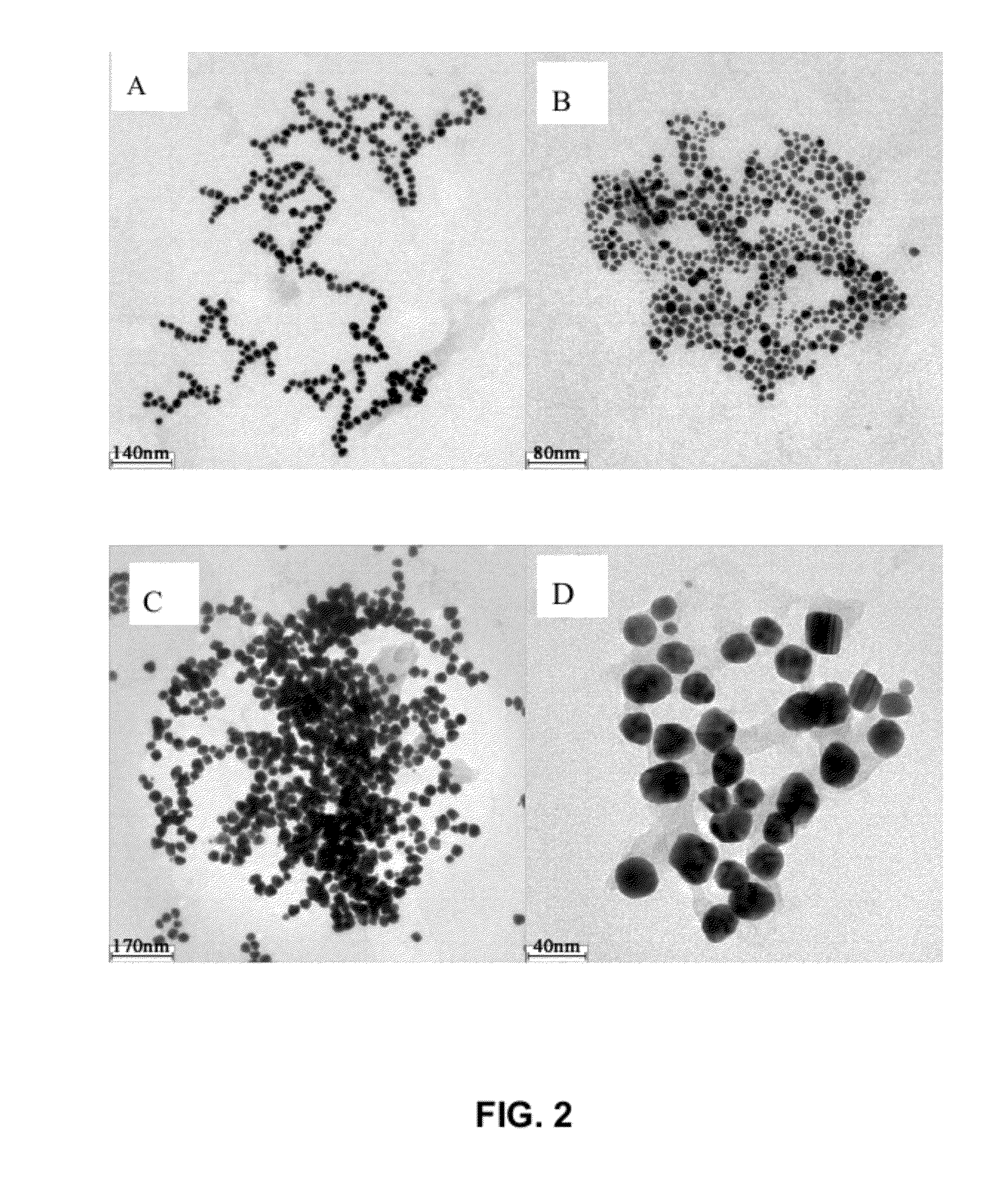Luminescent gold nanoparticle functionalized by n-(4-aminobutyl)-n-ethylisoluminol, preparation and application thereof
- Summary
- Abstract
- Description
- Claims
- Application Information
AI Technical Summary
Benefits of technology
Problems solved by technology
Method used
Image
Examples
example 2
[0119]Effect of the amount of chloroauric acid on the nanoparticle size in synthesis of N-(4-aminobutyl)-N-ethylisoluminol functionalized gold nanoparticles.
[0120]Mixing and stirring 9 mL 6 mmol / L chloroauric acid aqueous solution (chloroauric acid aqueous solution A) with 30 mL ultrapure water (resistivity at 18.2 MΩ*cm) at 25° C., 5 mL 4 mmol / L N-(4-aminobutyl)-N-ethylisoluminol aqueous solution is added into the solution A, and stirring continuously for 2 hours, then adding 6 mL 6 mmol / L chloroauric acid aqueous solution (chloroauric acid aqueous solution B) stirring continuously for 1.5 hours. A stable N-(4-aminobutyl)-N-ethylisoluminol functionalized gold nanoparticle sol is obtained. The sol is stored at 4° C. in dark. The gold sol is purified with centrifugation, and is characterized under electron microscopy. Purification conditions: 1 ml of the gold sol is centrifuged in 17120*g for 45 minutes, and then the sediment pellet is dissolved in ultra-pure water to obtain purified...
example 3
[0125]effect of the amount of N-(4-aminobutyl)-N-ethylisoluminol on the morphology in synthesis of N-(4-aminobutyl)-N-ethylisoluminol functionalized gold nanoparticles.
[0126]Mixing and stirring 9 mL 6 mmol / L chloroauric acid aqueous solution (chloroauric acid aqueous solution A) with 30 mL ultrapure water (resistivity at 18.2 MΩ*cm) at 25° C., 4.5 mL 4 mmol / L N-(4-aminobutyl)-N-ethylisoluminol aqueous solution is added into the solution A, and stirring continuously for 2 hours, then adding 6 mL 6 mmol / L chloroauric acid aqueous solution (chloroauric acid aqueous solution B) stirring continuously for 1.5 hours. A stable N-(4-aminobutyl)-N-ethylisoluminol functionalized gold nanoparticle sol is obtained. The sol is stored at 4° C. in dark. The gold sol is purified with centrifugation, and is characterized under electron microscopy. Purification conditions: 1 ml of the gold sol is centrifuged in 17120*g for 45 minutes, and then the sediment pellet is dissolved in ultra-pure water to ob...
example 4
[0131]Effect of temperature on the synthesis of N-(4-aminobutyl)-N-ethylisoluminol functionalized gold nanoparticles.
[0132]Mixing and stirring 9 mL 6 mmol / L chloroauric acid aqueous solution (chloroauric acid aqueous solution A) with 30 mL ultrapure water (resistivity at 18.2 MΩ*cm) at 15° C., 5 mL 4 mmol / L N-(4-aminobutyl)-N-ethylisoluminol aqueous solution is added into the solution A, and stirring continuously for 2 hours, then adding 6 mL 6 mmol / L chloroauric acid aqueous solution (chloroauric acid aqueous solution B) stirring continuously for 1.5 hours. A stable N-(4-aminobutyl)-N-ethylisoluminol functionalized gold nanoparticle sol is obtained. The sol is stored at 4° C. in dark. The gold sol is purified with centrifugation, and is characterized under electron microscopy. Purification conditions: 1 ml of the gold sol is centrifuged in 17120*g for 45 minutes, and then the sediment pellet is dissolved in ultra-pure water to obtain purified functionalized gold nanoparticles. The ...
PUM
| Property | Measurement | Unit |
|---|---|---|
| Temperature | aaaaa | aaaaa |
| Temperature | aaaaa | aaaaa |
| Temperature | aaaaa | aaaaa |
Abstract
Description
Claims
Application Information
 Login to View More
Login to View More - R&D
- Intellectual Property
- Life Sciences
- Materials
- Tech Scout
- Unparalleled Data Quality
- Higher Quality Content
- 60% Fewer Hallucinations
Browse by: Latest US Patents, China's latest patents, Technical Efficacy Thesaurus, Application Domain, Technology Topic, Popular Technical Reports.
© 2025 PatSnap. All rights reserved.Legal|Privacy policy|Modern Slavery Act Transparency Statement|Sitemap|About US| Contact US: help@patsnap.com



